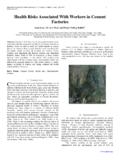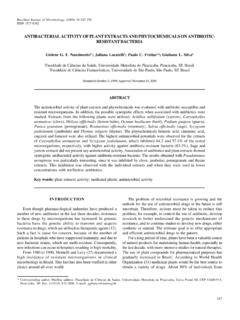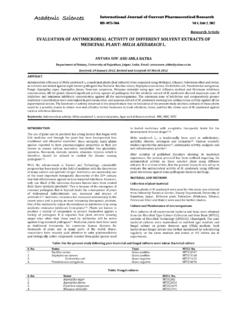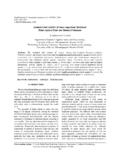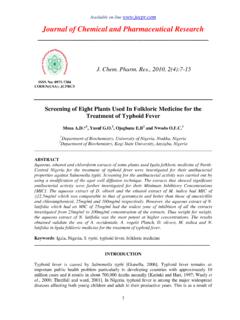Transcription of Phytochemical Screening of Selected Medicinal …
1 International Journal of Scientific and Research Publications, Volume 4, Issue 6, June 2014 1. ISSN 2250-3153. Phytochemical Screening of Selected Medicinal Plant Cinnamon Zeylanicum bark extract, Area of research;. Uttarakhand, India Snehlata Pandey*, Pandey**, Rita Singh*. *. Work carried out at IBT patwadangar-263128 Nainital,Uttarakhand,India. **. Department of Botany, Girls PG college. Rewa, 486001, India. Abstract- Medicinal plant of Cinnamon zeylanicum pertaining Region in the Uttarakhand were subjected to Phytochemical Screening to determine the presence of natural products (secondary metabolites) , alkaloids, steroids, flavonoids, saponins, protein, tannins and polyphenols, and glycosides which may be responsible for their therapeutic effects. extracts of this Medicinal plant was utilized the standard Screening method (Guevarra, et al, 2005) for the detection of secondary metabolites. The phytochemicals are important in human health this is because they display different biological activities such as antifungal, antibacterial activities.
2 Quantitative Phytochemical analysis of this plant confirms the presence of various phytochemicals like alkaloids. Flavonoids, tannins, saponins, steroid and glycosides in their six solvents cold, hot, warm water, acetone, ethanolic and methanolic bark extracts . The present study dealt with highlighting, of the phytochemicals with respect to the role of these plants in traditional system. Index Terms- Medicinal plants ; phytochemicals; Soxlet extraction I. INTRODUCTION. Cinnamon (Cinnamomum zylenicum) is commonly used in the food industry because of its special aroma. Additionally, it has strong antibacterial properties, anticandidial, antiulcer, analgesic, antioxidant and hypocholesterolaemic activities (Mastura et al. 1999; Lin et al. 2003). It is an ever green tropical tree, belonging to the Lauraceae family. Different parts of the plant (bark, roots and leaves). essential oils are used as a medicine. Due to its distinct odour, it is widely used as an important ingredient of many mouth watering dishes of the world.
3 Cinnamon has been reported to have remarkable pharmacological effects in the treatment of type II diabetes and insulin resistance (Hassan et al. 2012). Cinnamon is indicated as an analgesic and antipyretic agent against cold, fever, headache, myalgia (mascular pain), arthralgia (arthritic pain) and amenorrhea (failure of menstruation). In Indian traditional literature including Ayurveda, many other valuable actions are attributed to cinnamon bark ( Khory, Katrak, 1903). Many scientific pharmacological investigations are also reported on anti-inflammatory potential of the bark of many species of cinnamon. The anti-inflammatory action has been attributed to a series of tannins. The antinociceptive (analgesic) and antipyretic (fever reducing) activity were also been reported (Sachin vetal, 2013). In this context, the aim of the present study was the Screening of phytochemicals present in Cinnamomum zeylanicum aqueous bark extract. II. MATERIALS AND METHODS.
4 Collection and identification of plant materials The barks of healthy plant Cinnamomum zeylanicum were collected from local areas of patwadangar near nainital, uttarakhand between April to May 2012 for Phytochemical Screening . Preparation of plant extracts These barks were washed with distilled water to remove the adhering dust particles. They were dried in the shaded place. The dried barks were powdered, weighed and stored in clean containers. Aqueous Extraction (Maceration method). Powdered material of cinnamon zylenicum bark (5gm) is taken for maceration with 150 ml of distilled water for 1 hr on rotary shaker. The extract is filtered by using muslin cloth and Whatman filter paper and concentrated by evaporation on water bath. The extract was dried and used as a powder. There are various types of maceration method used . International Journal of Scientific and Research Publications, Volume 4, Issue 6, June 2014 2. ISSN 2250-3153. Cold Water maceration- 5g of dried plant powder was added to 150ml of distilled water (15 C) and was mixed thoroughly and kept it on rotary shaker for 1 h on 100 It was then filtered through muslin cloth or whatman filter paper.
5 Filtrate was taken and concentrated through evaporation on water bath at 70-80 c. The extract was weighted ( ) and stored in vial and kept in dessicator. Hot Water maceration- 5g of dried plant powder was added to 150ml of distilled water (70 C) and kept on rotary shaker for 1 hour. It was then filtered through muslin cloth or whatman filter paper. Filtrate was taken and concentrated through evaporation on water bath at 100 c. The extract was weighed ( gm) and stored in vial and kept in dessicator. Warm water maceration- 5g of dried plant powder was added to 150ml of distilled water (45 C) and kept on rotary shaker for 1 hour .It was then filtered through muslin cloth or What man filter paper. Filtrate was taken and concentrated through evaporation on water bath at 100 c. The extract was weighted (.21 gm) and stored in vial and kept in dessicator. Soxhlet extraction 5g of dried plant powder was extracted for 4-5 hrs with (150ml) organic solvent (ethanol, methanol, acetone, ether, chloroform etc.)
6 By hot continous perlocation method in Soxhlet apparatus. After the effective extraction ,solvent were concentrated using rotary flash evaporator and water was removed by evaporated to dryness on a hot water bath to yield a soxhlet crude extract. Qualitative analysis for Phytochemical components Collected plant samples that were identified to have Medicinal properties were subjected to Phytochemical Screening . Five hundred milligrams of the dried methanolic extract was reconstituted in 10ml of methanol and it was subjected to preliminary Phytochemical testing for the presence of different chemicals groups of compounds using standard methods. All plant parts were extracted on the day of collection. The Screening procedures were adapted from Guevara (2005). An extraction of each plant was prepared by macerating a known weight of the fresh plant material in an electric blender. Each extract was suction- filtered and the process repeated until all soluble compounds had been extracted, as judged by loss of color of the filtrate.
7 Extract from each plant part was evaporated to dryness in vacuo at about 45 C and further dried to a constant weight at the same temperature in a hot-air oven. A portion of the residue was used to test for plant constituents. The test for alkaloids was carried out by subjecting 20g plant material in 5 ml 2M HCl, heated, filtered and 2 to 3 drops Dragendorff's reagent was added. In the test for steroids, Salkowski test (To 2 ml of extract, 2 ml chloroform and 2 ml concentrated H2SO4 was added. Shack well, whether chloroform layer appeared red and acid layer showed greenish yellow fluorescence was observed). The presence of flavanoids was determined employing Shinoda test (added 5 ml 95% ethanol, few drops concentrated HCl and g magnesium turnings. Pink colour was observed.). The extract was subjected to Froth test for the identification of saponin. The tests for tannins and polyphenols were carried out by subjecting the plant extracts in Ferric chloride test.
8 Glycosides were identified by Legal's test For cardenoloids by subjecting 1ml pyridine and 1 ml sodium nitroprusside observed for pink to red colour and Kellar Killani test (To 2 ml extract added glacial acetic acid, one drop of 5% FeCl3 and concentrated H2SO4 observed for reddish brown colour at junction of the two liquid and upper layers bluish green). III. RESULTS AND DISCUSSION. Table 1 presents the results of the Phytochemical Screening of the Cold water, hot water, warm water, ethanolic, acetone and methanolic extracts of the Cinnamon plant's bark. In the preliminary test (test for primary metabolites), steroid alkaloid and saponin were detected in all plant extracts . Flavanoide was detected only in aceton ethanol and cold water extract. Carbohydrates present only in cold, hot and warm water extract. Ethanol, methano and acetone plant extracts were found to have tannin and phenol. Notably, protein and Glycosides were not detected in all plant extracts tested.
9 International Journal of Scientific and Research Publications, Volume 4, Issue 6, June 2014 3. ISSN 2250-3153. Table 1: Phytochemical Screening of secondary metabolites of plant extracts . phytoconstituents Cold Hot water Warm Ethanol Methanol Acetone water extract water ext extract extract Carbohydrates + + + _ _ _. Steroids + + + + + +. Protiens _ _ _ _ _ _. Glycosides _ _ _ _ _ _. alkaloids + + + + + +. Flavanoids + _ _ + _ +. Saponins + + + + + +. Tannins & phenol _ _ _ + + +. International Journal of Scientific and Research Publications, Volume 4, Issue 6, June 2014 4. ISSN 2250-3153. Table 2. Chemical basis Tests Reagents Positive result Carbohydrates test Conc. HCl Violet ring. Conc. HCl & Mg turnings Yellow and brick red precipitate test Proteins test 4%NaOH, 1% CuSO4 Violet or pink color Steroids Chloroform layer appeared red and 1. Salkowski test Chloroform and conc. H2SO4 acid layer show greenish yellow inflorescence Alkaloids Dragendorff's rgt.
10 Orange ppt. 1. Dragendorff's Saponin test 1. Froth test H2O, gogo Honeycomb froth Glycosides test 's test (for cardenoloids) Pyridine, Sodium-nitroprusside. Pink to red color. killani test Glacial acetic acid, 5% FeCl3. Reddish brown color &bluish green color Starch acid test 20% Tannic acid White ppt Flavanoids test 95% ethanol, HCl, Magnesium Pink color Tannins & Phenols 2. FeCl3 test FeCl3 Intense green colore IV. CONCLUSION. In this study, although there are variations in the chemical constituents, the six different plant bark extract of Cinnamon tested are potential antimicrobial agents. Characterization and isolation of the active chemical components possessed by this trditional plants for further study may lead to the development of a potential drug that may treat various kinds of infections and may lead to full utilization by the local community. The results of this study may also be of commercial interest to research institutes and pharmaceutical industries in the development of new dugs.









